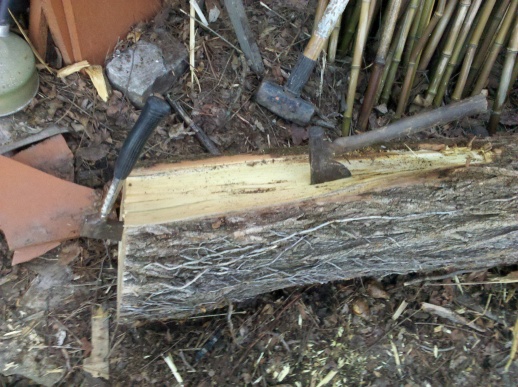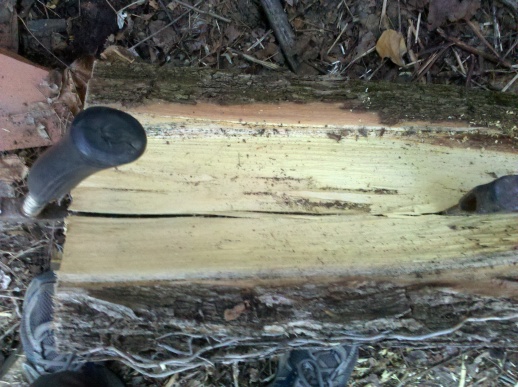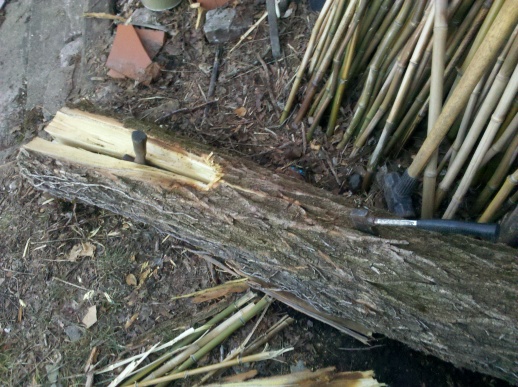Splitting Black Locust Logs With Wedges
by ajtarnas in Workshop > Woodworking
10539 Views, 54 Favorites, 0 Comments
Splitting Black Locust Logs With Wedges

Once a tree has been cut into logs, many species have straight enough grain that you can split them with wedges. I'll go through the steps below.
There are lots of videos on this general method. If you can find it somewhere, there's a good Roy Underhill "Woodwright's Shop" episode that includes splitting logs with glut (wooden wedge) and maul (heavy wooden hammer). Here's a video of a guy (not me, not my video) doing something very similar to what I'm about to describe:
Choose the Logs


Here you can see some 8' logs that could perhaps be split into two or three rails. Also shown is a pile of 4' rails that I already split. These logs came from a 70'+ black locust that I cut down because it was leaning over my house. (In its place I'll soon be planting some trees that won't get so tall.)
Get Your Tools

To do this work, you'll need some wedges, something to hammer the wedges, and some big prybars to yank the rails apart once you've mostly split them. In this case, the "wedges" that I'm using are two small hatchets and a 5lb steel log splitting wedge. I have a sledge hammer, a heavy 5' steel prybar, and a pickaxe. Another big prybar would be more useful than a pickaxe in this case. (Sorry about the photo, was getting late and camera was not flashing.)
You could alternatively use any number of other wedges and hammers. Dogwood is a common hardwood used for gluts (wooden wedges) and hickory root can be used for wooden mauls. I've made mauls from black locust roots and limbs and they work well. If you make yourself a variety of 5, 10, 15, 20 lb mauls and many 1" to 24" gluts, you'll be a true lumberjack in no time.
Ear protection would be a good idea (hammering metal hatchets and wedges with a metal sledge will make you deaf as a blacksmith after a while) and some safety glasses and heavy gloves are in order. Black locust has never exploded, kicked, or otherwise behaved badly for me, but sometimes you sledge in a wedge and it spits right back out of the crack at speed -- watch out! You don't want to stop an ejected hatchet with your face or your shin.
Begin the Split


Here I'm splitting a rather large 8' log that weighs considerably more than me. I weigh ~130lbs, this thing is more than 300lbs. I felled the tree in November, cut it into 8' lengths with my chainsaw, and left the logs to sit all winter. Now it's March, and the splitting is not difficult. I'm not sure how hard it would be to split logs in a different season, but my guess is that black locust would be much harder to split when it's still green (alive / just felled). Over the winter, small checks/cracks form in the end of the logs and propagate some distance. They aren't huge but they are a start.
Sledge your hatchet into the end of the log. In this case there's no pre-existing check that I'm following. I'm just going to split the log roughly down the middle of the diameter. Theoretically the heartwood (biological center) of the log and any knots from branches will be much more difficult to split through. This log has a scar at the other end which will act a bit like a knot, but the heartwood takes an axe well enough and the log will split fairly straight.
Once you've sledged the first hatchet into the end, the split will propagate 3' to 5' down the log. The second photo shows my second hatchet starting ~2' further along the crack.
Continue Down the Line




In this case, I was able to sledge in the second hatchet enough that the first hatchet fell out of the crack. Hatchet #1 then leapfrogs the now-embedded #2, and gets sledged into the travelling crack another roughly 2' down the line. Eventually the beginning point will show a significant gap, and the other end of the log will show the crack before you reach it.It's sometimes hard to see the crack propagate under the bark, but in this case the crack was clear. If it's not, make a good guess, or slice off the bark to see what's going on beneath.
Along the way, you'll want to angle your wedges this way or that to help the split travel true to your desired level of precision. In this case, I did the minimum amount of adjustment to end up with an acceptably straight rail. Other species of wood will split much more true with less effort, while some species need to be coaxed along the entire length with tiny 1"-3" wedges and many passes in order to get the desired end product, such as when making planks for a boat or siding for a house. There are some great "Viking shipbuilding" videos that show this. But I'm just making gnarly fenceposts here.
Reaching the End



This is where black locust's particularities become important. The wood is "stringy" -- it splits true enough, but large sheaves of fibrous wood connect across the crack even after the wedges have effectively gone through the entire log.
Sledge a hatchet into the end of the log where your split shows up, or define the end of the split if it hasn't shown up at the end yet. The crack will propagate, you are 90% complete -- but the last 10% of wood bridging the divide along the entire length of the crack is still much more tenacious than human hands can pry apart. At this point, break most of those fibers by sledging in the big iron wedge maybe 2' from the end.
You can use the big wedge earlier in this process, but the more narrow hatchets help define the whole split more carefully, whereas the wedge, when sledged completely into one end of the log, seems to lead the crack to taper or wander in undesirable ways.
Pry Apart



Black locust has this very stringy flesh. It's not fun to carve with a hand-chisel, and that same property shows up here at the end. Less than 1% of the wood in play is left bridging the gap, but it's still too strong to pry apart with your hands. Use large prybars to separate the rails. Some people use a chainsaw at this point to cut those final hangers-on. I weaken them with a few swings of the hatchet and then pry.
Done Deal

The log is split into rails. I'll go on to split each of these in half as well. So this 8' long, 300lb log will yield four posts, each 70+ lbs. The first split through the whole diameter of a log, and any splits that run into knots, will generally take the longest. I think making this initial split took me less than 10 minutes.